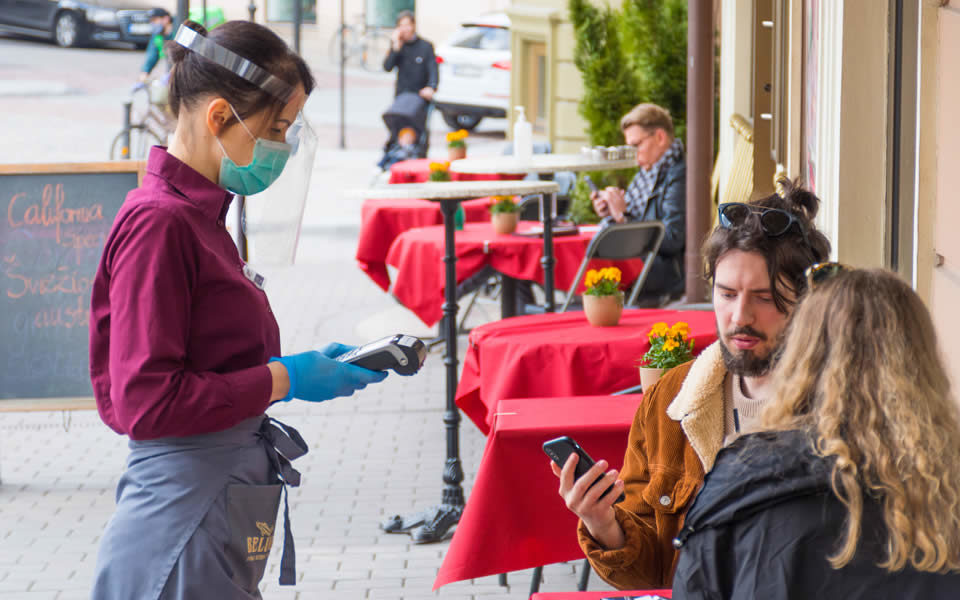Responsible Reopening – Part Two: Employment Best Practices and Supply Chain Concerns
By Patrick O’Reilly, Principal, Advisory Services
In this unprecedented time, innovation is the key to survival. The pandemic has precipitated a sea change in the way we do business. The true innovator is the one who can rise to the challenge and find ways to thrive. This is true not only in restaurant operations and design, but also with employment issues and in ensuring a consistent supply chain.
Getting Employees Back to Work
First and foremost, restaurant operators need to do everything they can to keep their staff as safe as possible. This starts at home. Staff must be aware of the risks they take when going out or socializing with others. If they make contact with someone who is sick or had been exposed, they must know to communicate to their employer what the situation is. Employees should be regularly taking their temperature before leaving to go to work or immediately at work if provided a way to do so. If sick, stay home. Employers should, where possible, make accommodations for staff who have at risk issues themselves or live with people who are at elevated risk.
Several of our clients are making such accommodations. One has a dessert chef who lives with a cancer patient at an end stage of life. The client set her up with the tools she needs to bake at home and deliver the goods to the restaurant during off hours. Another has a prep cook with severe asthma who is coming in during the wee hours of the morning when no one else is in, to do his work. This isn’t possible for all situations, but we must be willing to get creative.
There will be absences, walk outs, and send-homes, so be prepared by over-scheduling or, better yet, have an on-call slot for key shifts where the employee gets paid whether they work or not. Plan to succeed.
If possible, try to schedule staff in permanent groups so that the same people are being exposed to one another and not potentially cross contaminating the entire staff, which could be catastrophic. The bottom line is many of the pitfalls of spreading the virus can be mitigated by communicating with your customers, communicating with your staff, and communicating within the management crew.
Training
Plan on spending a couple shifts with your staff prior to re-opening to review the procedures that you have thought out and established. Review how curbside pickup and delivery will integrate with your in-house customers. How will you direct customer flow from host to table to restroom to exit? Lay out a plan and try to enforce it by sending the same consistent message to all staff.
Review when and how they should be wearing face coverings and how often they should be cleaned. We all know now the proper hand washing techniques, but preparing, handling, and serving food and drinks elevate the frequency and importance of this essential task—even in the restaurant industry, where it has always been paramount.
The cleanliness and sanitation protocols laid out by your respective CDC office should be followed as closely as possible. I won’t dive into this much here, but the guidelines should be used religiously and be on-hand should a question arise or a customer issue comes up. Please remember that the guidelines are a moving target and should be checked for changes at least weekly.
Reemployment
So you have now done your homework, made your space safe and socially distant, and you are ready to ramp up your employment again. Maybe you have a PPP loan and want to pay folks to come back to work part time at a higher rate of pay, so you can meet the requirements of the loan forgiveness. Most restaurants are probably halfway or more through their 24-week period.
If you have recalled employees who have not come back for a variety of reasons, be sure to document that you recalled them in writing with the date, the number of hours, and the pay rate offered. Some will not come back because they have child care issues, or are caring for an at-risk loved one, or they have health concerns themselves. Regardless of the reason, in order for these re-employment rejections not to hurt your PPP loan forgiveness application, you must have them documented and reported to your state unemployment office.
The pessimist in me thinks that many are not returning to work because they were receiving an extra $600 in federal unemployment weekly benefit, on top of what their state is providing. These folks may be counting on the feds extending that benefit, which terminated at the end of July. Congress is currently debating a possible extension, which could be retroactive perhaps reaching out as far as next January. Stay tuned for updates on this and how it will impact your business.
What if we do everything we are supposed to do as restaurant operators, and there is another spike in COVID cases or people still just don’t feel safe dining in a restaurant? I suspect there is pent up demand that will drive better sales to start, but then there very well could be a leveling off that is below expectations? Will there be another round of layoffs or reduced hours for employees?
I could go into a deep discussion of why the feds set a flat $600 supplemental amount, but let’s just make it simple by saying that the various state unemployment offices couldn’t facilitate variable calculations. Fine–that is what we have to live with at this point. The $600 was arrived at by taking the dollar amount that, on average across the country, would come closest to coming to replacing 100% of a worker’s income when factoring in an average weekly state unemployment check. That may be working to a degree in more populous and urban states, but in many rural and less populous states, the $600 supplement has had an effect counter to the intention of unemployment payments where it is disincentivizing a return to work. In my home state of Maine, workers are receiving about 130% of their pre-COVID pay through unemployment. This is creating a very precarious position for many businesses, not just restaurants.
Supply Chain Concerns
We all saw the toilet paper shelves empty in mid-March, on the news every night. That panic purchasing really sent things haywire, but we seem to have caught back up with some of this demand. There was a lot of disruption along the way though. Producers were dumping excess milk and plowing under fields as there was no market for the products. Processors had outbreak issues in many plants, and packaging dilemmas that came with switching from food service sizing to consumer sizing.
Transportation and handling were probably some of the least affected, but they were caught in the middle of the transition from eat-out to retail sales. Wholesalers that had major concentrations in restaurant and other closed outlets were hurt tremendously as they had to pivot and diversify quickly. Some moved to direct-to-consumer grocery sales, but many made huge food bank donations to move product prior to spoiling. With restaurants closed to diners, most moved to delivery and take out, while many consumers moved to grocers and other traditional retailers as well as big box retailers.
Key Vendors & Partners
We feel it is important to touch on a couple of items that may be somewhat within your control as a restaurant operator, or at least are worth inquiring about in these difficult times. As you resupply in anticipation of a reopening, consider asking for extended terms from landlords, banks and other creditors, or perhaps different payment options, as cash flow will likely be tight for a while. Ask if vendors will take credit card payments if they are unwilling to extend payment terms. This may buy you some additional time to pay as well as earn you miles or credit card points.
Many people reached out to landlords for a rent deferment in March, and then got PPP loans. Go back to your landlord and ask them to accept full rent payments now, which may be forgiven in the PPP forgiveness application, and ask them to defer July and/or August rent instead. Offer to pay your CAMs but ask to defer rent to show your partnership with your landlord in your businesses success.
Reach out to your key suppliers and review when and how you want them entering your space. Try to stagger deliveries, and if you have storage, order larger amounts less often to limit exposure.
Lastly, if you didn’t have an operating line of credit consider applying for one. Many lenders will extend $50,000 lines with very little underwriting. You will likely have to sign a personal guarantee, but having a buffer for cash flow purposes can be lifesaving.
Coronavirus Resource Center
Have more questions about the impact of the coronavirus on your business? Visit Marcum’s Coronavirus Resource Center for up-to-date information.





















